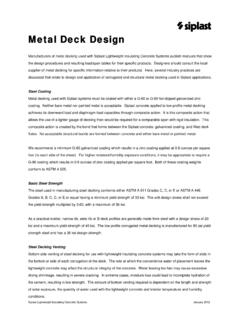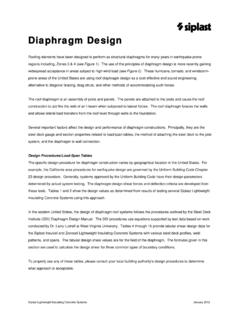Transcription of Siplast Roof Insulation Systems
1 Thermal Values Roof insulations must perform the basic function of helping to control fluctuations in building interior temperature relative to changing exterior temperatures. By reducing interior temperature fluctuations, the comfort of building inhabitants is improved and the air conditioning or heating costs can be controlled. Several factors affect the selection of design thermal values for Insulation materials. The performance of roof Insulation is also affected by additional factors relative to application of the system . Roof Insulation Thermal Values The thermal values of Insulation materials are determined by ASTM standard test methods. ASTM standards C 518 and/or C 177 define specific conditions known as steady-state for determination of a material's thermal properties. In summary, these steady-state conditions for determination of K-factors are: 1. The material must be homogeneous through its thickness. 2. The Insulation mean temperature must remain constant during the thermal property measuring process (steady-state condition).
2 3. The Insulation must maintain constant mass during the measuring process. The result of these measurements is the thermal conductivity or K-factor for the material at the specific mean temperature during measurement. The typical mean temperature used by Insulation manufacturers is either 40 F or 75 F. Other mean temperatures may be used but may not be representative of roof temperature conditions in the United States. The R-value or thermal resistance value is determined from the above test measurements using the formula: R = 1K factor The R-value is expressed as R per inch for design purposes. Table 1 shows R-values for Siplast Roof Insulation materials and other Insulation materials. Roof Insulation Design Generally, when a designer specifies an Insulation , he or she may request that the roof Insulation provide a minimum R-value or, when a sloped system is installed that the Insulation meet an average R-value. To assist the designer, manufacturers publish tables of Insulation values for various thicknesses or combination of materials used in roof Insulation .
3 Siplast lightweight insulating concrete Systems January 2012 Siplast lightweight insulating concrete Systems January 2012 The following tables list the Insulation values for Siplast Roof Insulation Systems . The tables show a U-value, R-value and C-value for several thicknesses of Siplast Roof Insulation Systems . A U-value incorporates the total system approach to Insulation design. The U-value includes the thermal resistance values for roofing and both inside and outside air films in addition to the Insulation material. The C-factor is similar to the K-factor but it applies only to the total thickness of the Insulation material. It does not include air films or roofing materials. R-value is the reciprocal of the C-value and also applies only to the Insulation materials. Roof Insulation Performance In-place performance of roof insulations can be significantly different than the expected performance based upon design criteria. The reason for this difference may be some or all of the following: 1.
4 The outside temperature changes so that steady-state design conditions are never created. 2. All insulations contain some moisture which can reduce Insulation performance. 3. Systems may be installed with gaps and/or fasteners through the Insulation and steel deck, which create thermal shorts or localized conditions of high heat flow. 4. Loss of blowing agents in insulations like isocyanurates reduce their thermal design values with time. Siplast lightweight insulating concrete Systems January 2012 Table 1 R-Values of Roof Deck Components R/Inch Definitions Zonolite insulating concrete 1:6 Mix, 1" ZIC 1:4 Mix NVS concrete , 1" Insulcel concrete , 1" Zonocel concrete , 1" Insulperm insulating Board, 1 Steel Decking Structural concrete (140 pcf), 1" Medium Weight concrete (100 pcf), 1" Glass Fiber Board, 1" Expanded Perlite Board, Organic Bonded, 1" Dens Deck, " Gypsum Foamboard, " Outside Air Film (heat flow up-winter) 15 mph Outside Air Film (heat flow down-summer) 7 " mph Inside Air Film (heat flow up-winter) Inside Air Film (heat flow down-summer) Built-Up Roofing Polyisocyanurate.
5 Fiberglass Faced, 1" Poured Gypsum ( wood chips), 1" Extruded Polystyrene ( pcf), 1" Thermal Conductivity (k) the thermal transmission, by conductance only, through a one-inch thickness of homogeneous material. Express as sq. ft. F. Thermal Conductance (C) - similar to thermal conductivity but broader. It applies to any thickness of homogeneous and heterogeneous material. Expressed as BTU/hr. sq. ft. F. Thermal Resistance (R) - the reciprocal of thermal conductance (C). Expressed as F hr. sq. Thermal Transmittance (U) also known as overall heat transfer coefficient. The transmission of the heat through a construction air to air. Express as BTU/hr. sq. ft. F. Authority for Values: ASHRAE Handbook of Fundamentals, Independent Laboratories, Manufacturer's Literature. NRCA Roofing and Waterproofing Manual. Siplast lightweight insulating concrete Systems January 2012 Thermal Values for 1:6 ZIC Designs Over Metal Decks Thermal Values Based on 2 inches of 1:6 Zonolite concrete with or without Insulperm over metal decking 26 Ga.
6 Metal ---- 15/16" Corrugation 24 Ga. Metal ---- 1-5/16" Corrugation 22 Ga. Metal ---- 1-1/2" B-Decking Thickness Weight U-Factor* Weight U-Factor* Weight U-Factor* of of Metal, of Metal, of Metal, Insulperm Insulperm, No Ceiling Insulperm, No Ceiling Insulperm, No Ceiling & Zonolite Heat Flow & Zonolite Heat Flow & Zonolite Heat Flow concrete concrete concrete (Inches) (PSF) UP Down (PSF) UP Down (PSF) UP Down 0" 1" 1-1/2" 2" 2-1/2" 3" 3-1/2" 4" 5" 6" 7" 8" 9" 10" 11" 12" *Includes air films and roofing membrane Notes: 1. ZIC properties are based on the material at minimum dry density. The thermal conductivity data is derived from independent testing of materials in accordance with ASTM Specification C 177.
7 Thermal conductivity of roof Insulation components is based on 40 F mean temperature. U-factors are based on series-parallel heat flow calculations defined in the ASHRAE Handbook of Fundamentals and are shown in constant thickness Insulation . All values shown are intended only as guidelines. Insulation performance for all materials and/or Systems is affected by building environment, installation and design procedures which may cause variations from calculated values. 2. A roofing membrane will add the following typical weights to the system weight listed above: Modified Bitumen 2 pounds per sf 4 ply built-up roof with gravel 6 pounds per sf Mechanically fastened single ply pounds per sf Thermal Values for 1:4 ZIC Designs Over Metal Decks Thermal Values Based on 2 inches of 1:4 ZIC with or without Insulperm over metal decking 26 Ga. Metal ---- 15/16 Corrugation 24 Ga. Metal ---- 1-5/16 Corrugation 22 Ga. Metal ---- 1-1/2 B-Decking Thickness Weight U-Factor* Weight U-Factor* Weight U-Factor* of of Metal, of Metal, of Metal, Insulperm Insulperm, No Ceiling Insulperm, No Ceiling Insulperm, No Ceiling & Zonolite Heat Flow & ZonoliteHeat Flow & Zonolite Heat Flow concrete concrete concrete (Inches) (PSF) UP Down (PSF) UP Down (PSF) UP Down 0" 1" 1-1/2" 2" 2-1/2" 3" 3-1/2" 4" 5" 6" 7" 8" 9" 10" 11" 12" *Includes air films and roofing membrane Notes: 1.
8 ZIC properties are based on the material at minimum dry density. The thermal conductivity data is derived from independent testing of materials in accordance with ASTM Specification C 177. Thermal conductivity of roof Insulation components is based on 40 F mean temperature. U-factors are based on series-parallel heat flow calculations defined in the ASHRAE Handbook of Fundamentals and are shown in constant thickness Insulation . All values shown are intended only as guidelines. Insulation performance for all materials and/or Systems is affected by building environment, installation and design procedures which may cause variations from calculated values. 2. A roofing membrane will add the following typical weights to the system weight listed above: Modified Bitumen 2 pounds per sf 4 ply built-up roof with gravel 6 pounds per sf Mechanically fastened single ply pounds per sf Siplast lightweight insulating concrete Systems January 2012 Siplast lightweight insulating concrete Systems January 2012 Thermal Values for 1:6 Zonolite concrete Design Over Type N-24 Metal Deck Thermal Values Based on 2 inches of 1:6 Zonolite concrete with or without Insulperm over metal decking 22 Ga.
9 Metal Type N 3 Profile Thickness Weight U-Factor* of of Metal, Insulperm Insulperm, No Ceiling & Zonolite Heat Flow concrete (Inches) (PSF) UP Down 0" 1" 1-1/2" 2" 2-1/2" 3" 3-1/2" 4" 5" 6" 7" 8" 9" 10" 11" 12" *Includes air films and roofing membrane Notes: 1. ZIC properties are based on the material at minimum dry density. The thermal conductivity data is derived from independent testing of materials in accordance with ASTM Specification C 177. Thermal conductivity of roof Insulation components is based on 40 F mean temperature. U-factors are based on series-parallel heat flow calculations defined in the ASHRAE Handbook of Fundamentals and are shown in constant thickness Insulation . All values shown are intended only as guidelines. Insulation performance for all materials and/or Systems is affected by building environment, installation and design procedures which may cause variations from calculated values.
10 2. A roofing membrane will add the following typical weights to the system weight listed above: Modified Bitumen 2 pounds per sf 4 ply built-up roof with gravel 6 pounds per sf Mechanically fastened single ply pounds per sf Siplast lightweight insulating concrete Systems January 2012 Thermal Values for NVS concrete Designs Over concrete and Reroofing Substrates Values Based on 1 Inch of NVS concrete Values Based on Inches of NVS concrete Thickness Dry Weight Wet Weight U - Factor Dry Weight Wet Weight U - Factor of of of of of Insulperm Insulperm Insulperm No Ceiling Insulperm Insulperm No Ceiling & NVS & NVS & NVS & NVS concrete concrete Heat Flow concrete concrete Heat Flow (Inches) (PSF) (PSF) UP DOWN (PSF) (PSF) UP DOWN 0" 1" 1-1/2" 2" 2-1/2" 3" 3-1/2" 4" 5" 6" 7" 8" 9" 10" 11" 12" *Includes air films and roofing membrane Notes: 1.









